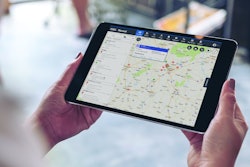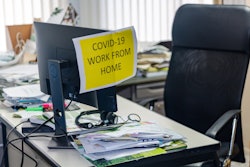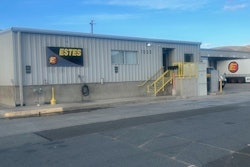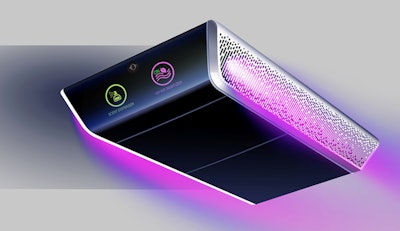
Air filters have been known to capture viruses and a lot of other nasty microscopic things, so take special care when changing one out in the cab.
That advice comes from leading air filtration expert Dr. Jeffrey Siegel, professor of Civil and Mineral Engineering at the University of Toronto.
“There are articles in the literature where people have taken virus DNA and RNA off of filters, and I myself have taken fungal and bacterial DNA off of filters so we know filters can be active microbiologically,” Siegel explained.
What’s not clear, Siegel said, is the level of risk in handling such filters which can vary depending on things like filter efficiency, air quality and filter changing regimen. Nonetheless, in the wake of COVID-19 as commercial trucks continue to hit the road at various places along the way, Siegel advises that it’s best to err on the side of caution.
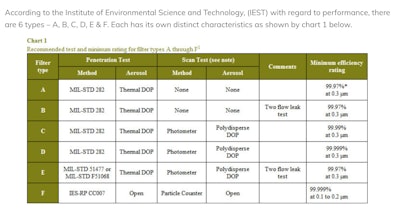 HEPA air filter categories posted by the National Air Filter Association.
HEPA air filter categories posted by the National Air Filter Association.“Wear gloves,” Siegel advised when removing a filter. “Do it with the doors and windows open so that there’s a lot of air flow from the outside in, put it in a sealed bag and get rid of it. Again, I’m not sure there’s an actual risk there, but those are all easy steps to do and if there is a risk, it deals with it.”
Will increasing the frequency of cabin air filter changes help?
“So this is a really interesting issue,” Siegel said. “First, I should say I don’t know. The second thing I would say is that most of what that filter’s collecting is traffic pollution and other things, and also things related to activities in the cabin. But we’re not really worried about this as a virus risk. Having said that, filters really do collect lots of nasty stuff.”
The COVID-19 virus is considered a large virus at .12 microns in diameter according to the Plasma Protein Therapeutics Association (PPTA), a trade group that represents the biologics and biotechnology industry.
Cabin air filters vary in efficiency with some manufacturers advertising capability in Minimum Efficiency Reporting Value (MERV) or one of four categories set by the International Organization for Standardization’s (ISO) series 16890: ISO course, ePM10, ePM2.5 and ePM1. Whether using MERV or ISO ratings, each one refers to particle size capture ability typically in nanometers or microns.
According to the U.S. Food and Drug Administration, an N-95 respirator mask is rated to trap 95% of very small (.3 microns) test particles. High Efficiency Particulate Air (HEPA) filters, according to the National Air Filtration Association, offer a step up with at least a 99.7% efficiency rating for capturing test particles .3 microns in size. More sophisticated HEPA filters have a 99.99% rating for stopping particles of the same size.
At .12 microns in diameter, the COVID-19 virus is four times smaller than .3 microns, but that does not necessarily mean that the virus will pass right through a filter. Like other microscopic nasties, the virus hitches a ride, so to speak, on larger droplets of material, like saliva, emitted through coughing and sneezing, which can be stopped by air filters.
But seeking out the filter that catches the smallest amount of particles is not always the right choice. Some HVAC systems may not be rated to handle higher efficiency filters, which can lead to unwanted back-pressure and other HVAC problems, including a reduction in air flow.
Some devices are already equipped with exceptional filtration capabilities. IQAir states that its Atem 5-in-1 Personal Air Purifier is equipped with a HyperHEPA Plus filter that will capture 99.5% of particles measuring as small as .003 microns.
“As far as the coronavirus question, yes our filter technology does filter viruses,” said IQAir spokesperson Tiffany Allegretti.
A mounting accessory allows the device to be mounted behind vehicle head rests.
While Siegel said IQAir is a reputable company, a smaller micron rating does not necessarily equate to more effective virus control.
“There is not good evidence that a filter like that one is any better than, for example, a HEPA filter for this particular application,” Siegel explained. “And a big part of that reason is the fact that the virus size is not really relevant because the virus won’t last that long in the air by itself. The naked virus is somewhat vulnerable. What we really care about is that virus moving around in droplets and getting attached to other particles and those can be a lot of different sizes but they’re all bigger.”
UV light air filter options growing
Cab air filtration systems, along with face masks, are bound to get more attention in the days ahead. Last year, long before COVID-19 dominated headlines, Jaguar announced that it was developing an ultraviolet (UV-C) air filtration system for use in its Land Rover. Ultraviolet filtration systems have been in use for years in hospitals, businesses and homes where they’ve proven effective at killing viruses and bacteria. Jaguar posts on its website that “UV-C technology can help stop the spread of cold and flu, while reducing the transmission of major superbugs by up to 30%.”
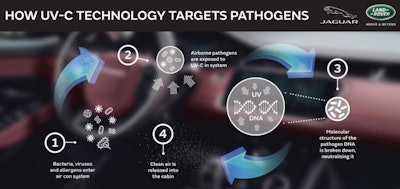 Jaguar is developing a UV-C air filter for its Land Rover which is designed to reduce viruses and other airborne health risks inside the cabin.
Jaguar is developing a UV-C air filter for its Land Rover which is designed to reduce viruses and other airborne health risks inside the cabin.Aftermarket UV systems intended for vehicle use are currently up for sale but exercise caution before clicking to buy.
“A bigger concern for UV lights in an automotive application is that if the wave length gets small enough, UV lights generate ozone and ozone is a respiratory element and it’s going to react with a ton of surfaces in the cabin and just create all kinds of really nasty stuff,” Siegel said. “Not all UV lights do that. It depends on their wave length. Cheap UV lights generate ozone and that’s an issue.”
Auto supplier Yanfeng Global introduced a UV-C filter for vehicle use this year at the Consumer Electronics Show. However, the design of the Wellness Pod does not permit the vehicle to be occupied during the UV-C surface and air cleansing process since exposure to UV-C may cause cancer. The device, which mounts to the interior roof of a vehicle, can clean an unoccupied cabin in roughly 30 minutes.
Other UV-C systems are encapsulated and do not permit harmful light waves to escape. Similar to HVAC systems used in buildings and homes, Jaguar’s UV-C filter is housed within the vehicle’s HVAC system and targets pathogens drawn inside the air intake.
Whatever the filtration system used, the bottom line, according to Siegel, is that air filtration is one of several tools in the fight against viruses, bacteria, fungi and other dangerous airborne matter. Social distancing, air filter masks (commercial N95 and homemade cloth masks), hand washing and surface disinfectants are others.
“From my perspective, I don’t worry about outdoor air at all, especially if people aren’t closer than about six feet from me,” Siegel said. “If you’re at a truck stop where vehicles are very close together then I guess there is some risk of contamination, but outside air is pretty big so that would dilute a lot of that risk pretty rapidly. I wouldn’t go crazy with filtration. There’s probably not that much benefit.”





